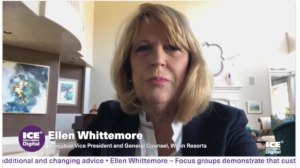The third day of ICE North America Digital focused on the brick-and-mortar industry, namely the path back to business for an industry shuttered since mid-March by novel coronavirus (Covid-19).
The day opened with speakers discussing the process of safely reopening casinos.
Michael Soll, president of the Innovation Group, began by explaining that location and local laws regarding social distancing will dictate how a venue bounces back. A combination of safety regulations, the economy and how customers feel will all affect whether a property is ready to return, Soll said.
Kelley Tucky of Ithos Strategic Communications, said the safety of employees was of the utmost importance, not just because of the importance of employee safety but also because of the negative public relations effect of risking employee health.
“It has to be employee-centric,” Tuckey said. “You have to put your employees first. Guests are looking at how you treat employees and if they don’t think you’re treating them well they’re not going to make a connection with you.”

The University of San Diego’s Katherine Spilde added that communicating with these employees was necessary, even if operators are still working on their plans.
“Don’t go silent, you need to let you’re employees know you have a plan even if you’re still working on it,” she said. “Personal interaction, even if it’s just a phone call from supervisors, will go far.”
Wynn Resorts Ellen Whittemore supported this assessment, explaining that the operator had devised its reopening plans with input from employees.
“We’ve worked from the bottom up, not the top down,” Whittemore said. “We spoke to slot managers asking how we can configure our slot floor to make sure people are physically distanced.”
Organisational transformation
Next came t2 Marketing International’s Corey Padveen and Edwards Technologies’ Brian Edwards discussing how casinos can reach their customers at a time when they can’t reach the property. The pair agreed that this effectively required an organisational transformation, in order to keep guests safe, happy and managed their expectations for a new sort of experience.
“We not only have to communicate with the guests, but also with the employees,” Edwards explained.

He admitted that there was no hope of a switch being flipped and business returning to normal, and therefore advocated scenario planning, in which venues set out a range of possible scenarios. This, Edwards added, required careful coordination between marketing and technology teams, allowing businesses to be prepared for each and every eventuality.
Padveen added that the marketing message had changed fundamentally: “The message is no longer ‘we have the best buffets’, but ‘we have the safest sanitation policies’.
Technology, they agreed, would facilitate these messages being communicated to the customer. Patrons’ smartphones effectively replaced in-venue digital signage as the way of doing so. This will likely see new logistical processes for check-in, new keycard systems, and in-room televisions becoming a dashboard for guests to coordinate their activities and actions.
This in turn would shift to greater adoption of automation. Being able to put minds at ease with constant messaging and readily available information would be a key component of the casino experience in future, Padveen added.
Beyond the casino floor
The conversation then turned to the impact of non-gaming amenities as a way of drawing customers back to casinos.
Industry executive Cynthia Kiser Murphy said – with outdoor interaction appearing safer than indoors – operators need to consider new ways to use outdoor space.
Lana Kotur, vice president of Customer Success at VizExplorer, added that while safety was important, there would still be other aspects involved in attracting customers.
“Customers and players are still looking for an experience,” While you want things to be safe and clean, it still needs to be a form of entertainment for players.
Murphy said conventions and events will have to be modified, and events that are a hybrid between in-person and digital may be common.
“There’s a lot of work being done now in the meeting and convention business about creating hybrid meetings, where some people can attend in person and others dial in,” she said.
However Sun Gaming and Hospitality’s Bobby Soper warned that the non-gaming amenities may be even slower to return to something approaching normal than gaming, because of the long-term economic ramifications of the pandemic.
“In the 2008 financial crisis, it really took 10 years before some important metrics like unemployment got back to where they were before that crash,” Soper said. “We have to hope we’re not in for that again and we have to plan for the potential long-term economic impact.”
Tribal perspective
The day concluded with Clarion Gaming’s Ewa Bakun interviewing the National Indian Gaming Association chairman Ernie Stevens. Discussing the impact of the pandemic on the tribal gaming industry, Stevens said it was above all a very sad situation.

He said the shutdown effectively put an industry that generates revenue of $40bn and supports 300,000 direct jobs – making it the 11th highest employer in the US – on hold.
“It has had a giant impact on our community, for us, for the services we provide,” he said. “The money from Indian gaming goes directly to taking care of our communities. It’s the toughest challenge in the world.”
However he admitted that a return to life as it was before Covid-19 was impossible, and therefore a “new normal” would have to be created. NIGA has a subcommittee that is working on devising a strategy for reopening, but chairman Stevens said this could only occur when it will not risk the health and safety of tribal communities.
“It doesn’t matter who we are, we’re all in this together,” he said.
Bakun asked chairman Stevens about the possibility of tribes embracing online gaming as a way to develop additional revenue in future, and he admitted that it was something that could be of interest.
However, he added, this could not replicate the social experience of being at a bricks and mortar venue.
“[I] think online gaming will be very valuable, but a safe environment where we can interact as humans, I look forward to that,” he said.
Read iGB North America’s recaps of Day 1 and Day 2 of ICE North America Digital, and remember, sessions are available on demand if you missed them.
If you’d like to explore these topics and more with your peers and a host of leading expert speakers, join us for ICE North America Digital today until this Friday, May 15. Find out more and register free here.




